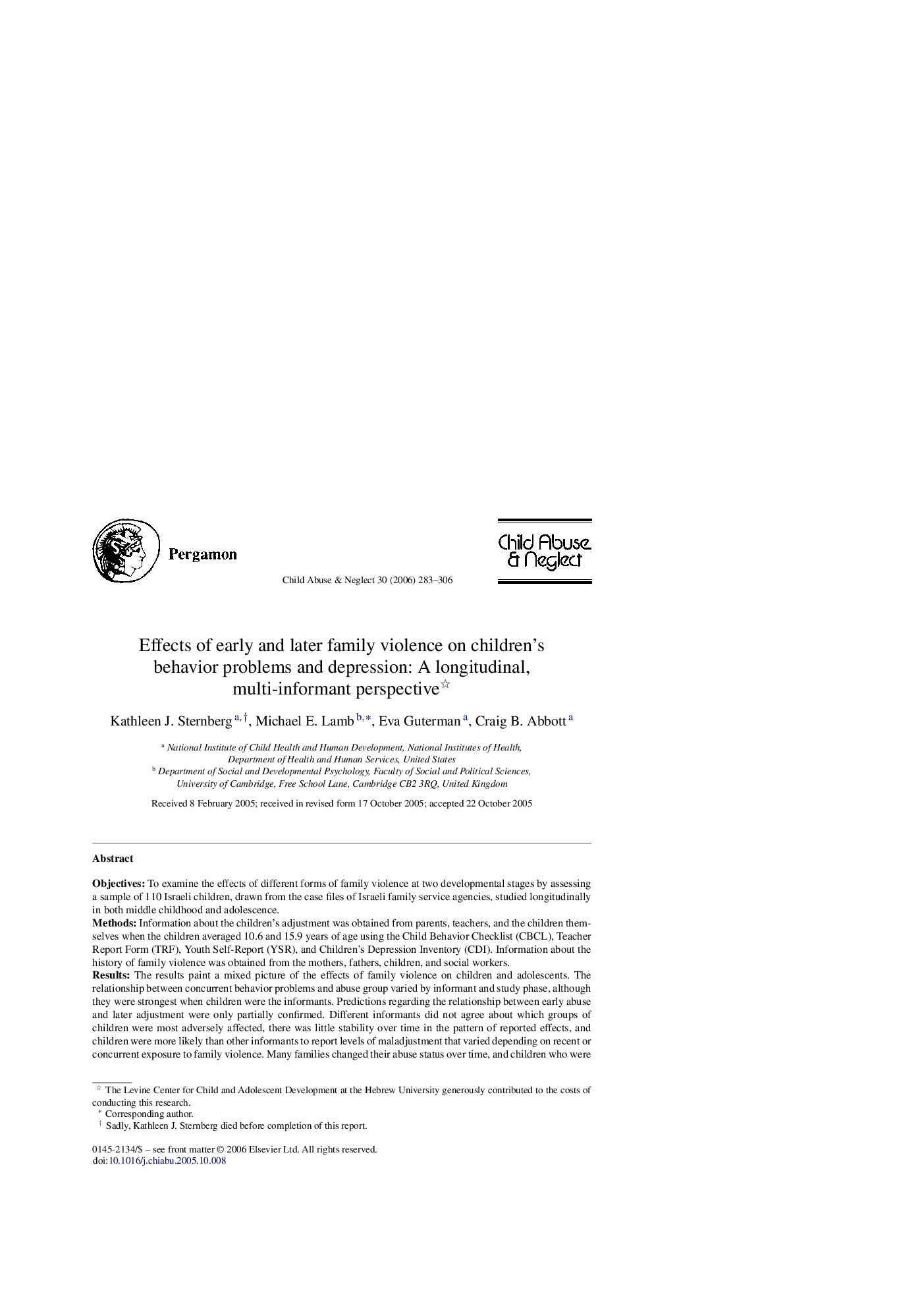| کد مقاله | کد نشریه | سال انتشار | مقاله انگلیسی | نسخه تمام متن |
|---|---|---|---|---|
| 345699 | 617547 | 2006 | 24 صفحه PDF | دانلود رایگان |

ObjectivesTo examine the effects of different forms of family violence at two developmental stages by assessing a sample of 110 Israeli children, drawn from the case files of Israeli family service agencies, studied longitudinally in both middle childhood and adolescence.MethodsInformation about the children's adjustment was obtained from parents, teachers, and the children themselves when the children averaged 10.6 and 15.9 years of age using the Child Behavior Checklist (CBCL), Teacher Report Form (TRF), Youth Self-Report (YSR), and Children's Depression Inventory (CDI). Information about the history of family violence was obtained from the mothers, fathers, children, and social workers.ResultsThe results paint a mixed picture of the effects of family violence on children and adolescents. The relationship between concurrent behavior problems and abuse group varied by informant and study phase, although they were strongest when children were the informants. Predictions regarding the relationship between early abuse and later adjustment were only partially confirmed. Different informants did not agree about which groups of children were most adversely affected, there was little stability over time in the pattern of reported effects, and children were more likely than other informants to report levels of maladjustment that varied depending on recent or concurrent exposure to family violence. Many families changed their abuse status over time, and children who were new victims at follow-up had the most internalizing problems. Girls were found to be at more risk for internalizing and externalizing behavior problems than boys.ConclusionsMultiple informants are necessary to evaluate and assess the effects of family violence on children's behavior. Younger children may be more susceptible to the effects of family violence than older children, but problems manifest by some children may not carry over to adolescence. Changes in family and parenting practices, as well as in children's capacity to appraise and cope with family violence may help mitigate the adverse effects of family violence.
RésuméFrench-language abstract not available at time of publication.
ResumenObjetivosExaminar los efectos de las diferentes formas de violencia familiar en dos momentos evolutivos evaluando una muestra de 110 niños israelitas, analizando los expedientes de las agencias de familia de Israel y haciendo un estudio longitudinal tanto en la infancia media como en la adolescencia.MétodosSe obtuvo información sobre el ajuste de los niños a través de la información proporcionada por los padres, los profesores y los propios niños cuando éstos tenían de media entre 10.6 años y 15.9 años. Se utilizaron el Child Behavior Checklist (CBCL), el Teacher Report Form (TRF), el Youth Self-Report (YSR) y el Children Depression Inventory (CDI). La información sobre la historia de violencia familiar se obtuvo de las madres, padres, niños y trabajadores sociales.ResultadosLos resultados presentan una mezcla de efectos de la violencia familiar en los niños y adolescentes. La relación entre los problemas de conducta y la violencia familiar varió según el informante y la fase del estudio, siendo más fuerte cuando los niños eran los informantes. Las predicciones sobre la relación entre violencia temprana y posterior ajuste fueron sólo parcialmente confirmadas. Los diferentes informantes no estaban de acuerdo acerca de qué grupos de niños fueron afectados de manera más adversa. Hubo poca estabilidad a lo largo del tiempo en los patrones de los efectos notificados. Los niños tenían más tendencia que otros informantes a notificar niveles de desajuste que variaban dependiendo de la exposición reciente o actual a la violencia familiar. Muchas familias cambiaron su situación de maltrato a lo largo del tiempo y los niños que fueron nuevas víctimas a lo largo del seguimiento tuvieron más problemas internalizados. Las niñas tenían más riesgo de problemas externalizados e internalizados que los niños.ConclusionesSe necesitan múltiples informantes para evaluar los efectos de la violencia familiar en la conducta de los niños. Los niños más jóvenes pueden ser más susceptibles a los efectos de la violencia familiar que los niños más mayores, pero los problemas manifestados por algunos niños pueden no continuar a partir de la adolescencia. Los cambios en las familias y en los comportamientos parentales así como la capacidad de los niños para asimilar y enfrentarse con la violencia familiar pueden ayudar a mitigar los efectos adversos de la violencia familiar.
Journal: Child Abuse & Neglect - Volume 30, Issue 3, March 2006, Pages 283–306